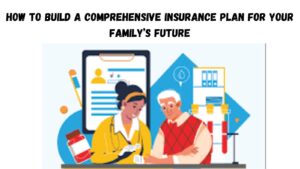The world of insurance is undergoing a dramatic transformation. By 2030, technologies like artificial intelligence (AI), machine learning, and big data will transform how we write, price, and manage insurance policies. The future of insurance will look very different from today. We’ll see fully automated underwriting and personalized premiums on the rise. In this article, we’ll look at key trends that will shape the future of insurance. These trends include AI integration, automation, and “insurance as a service.”

The Rise of Automation in the Insurance Industry
Contents
- 1 The Rise of Automation in the Insurance Industry
- 2 Personalized Premiums: Insurance Tailored to You
- 3 The Concept of “Insurance as a Service” (IaaS)
- 4 The Role of Blockchain in Insurance
- 5 Impact on Consumers and the Insurance Industry
- 6 Fun Facts About the Future of Insurance
- 7 Conclusion: The Future is Now
- 8 FAQs About the Future of Insurance
- 9 How will automation impact the insurance industry in 2030?
- 10 What are personalized premiums, and how will they work in 2030?
- 11 What is “Insurance as a Service” (IaaS)?
- 12 How will blockchain impact the insurance industry?
- 13 Will the gig economy affect insurance policies in 2030?
In the next decade, automation will play an increasingly vital role in the insurance industry. Insurance companies use automated systems for claims processing. In the future, they will automate more tasks. These include policy underwriting, customer service, and risk assessment. By 2030, 80% of insurance tasks are expected to be automated. This change will come from advances in AI, machine learning, and robotic process automation (RPA).
Automated Underwriting: The End of Manual Labor?
Traditionally, underwriting has been a manual and often time-consuming process. Underwriters analyze risks, evaluate applicants, and determine premiums based on a set of criteria. However, AI and machine learning are already transforming this process. With the ability to analyze vast amounts of data in seconds, AI can evaluate risks more accurately and quickly than a human underwriter. This could create a future where underwriting is fully automated. Algorithms quickly decide based on a person’s health, driving record, finances, and social media.
Real-Life Example: In 2020, Lemonade launched AI-driven underwriting. This lets the company approve policies in just minutes. Their “AI Jim” chatbot evaluates a user’s risk profile and provides an instant quote, streamlining the entire process. By 2030, all insurance companies might use similar models. This change could cut processing time and lower costs.
AI-Powered Claims Processing
The claims process will also see a massive shift toward automation. AI chatbots and virtual assistants will handle tasks such as claim submission, assessment, and approval. This can help reduce human error, speed up claims processing, and improve customer satisfaction. In fact, AI-powered chatbots are expected to handle over 50% of customer service queries in the next five years.
Interesting Story: Zego Insurance shows how AI can improve claims processing. They use AI to make fleet insurance claims faster and easier. The system uses telematics data from vehicles. It automatically checks the claim’s severity and figures out payouts. This cuts down on a lot of manual work.
Personalized Premiums: Insurance Tailored to You
By 2030, insurance policies will be more personalized. This change will happen because of data analytics and machine learning. Today, premiums are based on a range of general factors, such as age, location, and occupation. As insurers get more personalized data, they can evaluate risk for each person. This will result in very tailored premiums.
Telematics and Wearables: Pay As You Live
Wearables and IoT devices will give insurance companies real-time data in the future. This will help them set premiums based on a person’s lifestyle. For example, car insurance may be priced based on how safely you drive, with the help of telematics devices installed in vehicles. Health insurance premiums could also change based on fitness trackers. These devices monitor your physical activity, sleep patterns, and dietary habits.
Real-Life Example: Progressive’s Snapshot program, which offers discounts based on driving behavior, is a glimpse of what’s to come. By 2030, personalized insurance models like this will become the standard. People will pay based on their behavior. This includes how much they exercise, how safely they drive, or how often they use the insurance app.
AI and Data-Driven Pricing
In the future, AI and big data will be used to personalize premiums in a way that’s far more accurate than anything we see today. Insurers can analyze real-time data from many sources. This includes financial behavior, health metrics, and social media activity. By doing this, they can set premiums that match an individual’s risk profile. This could allow for more competitive and fair pricing.
The Concept of “Insurance as a Service” (IaaS)
Another major trend that will define the future of insurance is the rise of “Insurance as a Service” (IaaS). This model offers on-demand insurance. It has flexible terms, similar to a subscription service.
What is Insurance as a Service?
Insurance as a Service lets consumers buy coverage for short-term needs. This gives them more control and flexibility over their policies. You can buy car insurance for a day, week, or month instead of a year. This way, you get coverage that fits your needs right now.
Real-Life Example: In travel, Trov offers on-demand insurance for electronics, luggage, and trips. By 2030, this model might grow to include more insurance types, like auto, health, and home. This will give consumers the chance to change their policies instantly.
On-Demand Coverage for the Gig Economy
As more people engage in gig and freelance work, the demand for flexible insurance policies will rise. In the future, workers in the gig economy may opt for insurance that covers them only when they are working. On-demand insurance can help if you drive for a rideshare company or work as a freelancer. It offers coverage only when you need it. This way, you don’t have to pay for year-round premiums.
The Role of Blockchain in Insurance
Blockchain is famous for cryptocurrencies. However, it will also greatly affect the insurance industry. It can help increase transparency, reduce fraud, and streamline claims processing.
Fraud Prevention and Smart Contracts
By 2030, blockchain may be common in insurance. It can help with smart contracts. These contracts run on their own, and the deal’s terms are written in code. This can cut out intermediaries, lower admin costs, and streamline the claims process. Blockchain’s transparency helps insurers track and verify data. This greatly cuts down on fraud risk.
Real-Life Example: Axa, a French insurance firm, has launched a blockchain solution for flight delay insurance. With this system, customers automatically get compensation for flight delays. They don’t need to file a claim. By 2030, blockchain could play a key role in automating many aspects of the insurance process.
Impact on Consumers and the Insurance Industry
For consumers, the future of insurance promises more convenience, personalization, and flexibility. The shift toward automation and AI-driven underwriting will make it easier to get quotes and manage policies. Personalized premiums will reward people for being healthier or driving safely. Also, on-demand insurance will offer coverage when and where it’s needed most.
For the insurance industry, this transformation will bring both opportunities and challenges. On one hand, automation will reduce costs, improve efficiency, and allow insurers to offer more competitive prices. The industry needs to change. There is a rising demand for transparency, data privacy, and consumer control over insurance policies.
Fun Facts About the Future of Insurance
- Micro-Insurance: By 2030, “micro-insurance” could emerge. This option allows people in developing countries to buy affordable, short-term coverage. It protects them against specific risks, such as crop failure or natural disasters.
- AI Chatbots: By 2030, 50% of all customer service inquiries in insurance will be handled by AI-powered chatbots. These bots can handle claims, answer questions, and even assist in policy management.
- Predictive Analytics: Insurers will use predictive analytics to foresee possible claims. They can adjust policies in real-time to match changing risks.
Conclusion: The Future is Now
The future of insurance in 2030 promises to be a blend of automation, personalization, and flexibility. AI and blockchain are advancing. This will make insurance policies more tailored, cheaper, and easier to access. Consumers gain more control over their coverage. Insurers will use efficiencies and data insights to enhance the customer experience.
The future of insurance has many exciting possibilities. But it will also face challenges, like data privacy, security, and regulation. However, one thing is clear: the evolution of insurance is inevitable, and the next decade will redefine the way we think about risk and coverage.
The Rise of Usage-Based Insurance: How Telematics is Changing Car Insurance
FAQs About the Future of Insurance
How will automation impact the insurance industry in 2030?
Automation will speed up underwriting, claims processing, and customer service. It will also make these processes cheaper and more efficient.
Personalized premiums are insurance rates made just for you. They consider your behavior, lifestyle, and risk profile. This could include factors like driving habits, fitness levels, or even social media activity.
What is “Insurance as a Service” (IaaS)?
Insurance as a Service lets consumers buy coverage when they need it. This model offers flexibility and control over policies, much like a subscription service.
How will blockchain impact the insurance industry?
Blockchain boosts transparency, cuts fraud, and automates claims with smart contracts. This makes insurance more efficient and secure.
Will the gig economy affect insurance policies in 2030?
Yes, more gig and freelance work will create flexible, on-demand insurance policies. Workers can pay for coverage only when they need it.
This comprehensive guide looks ahead to the future of insurance and how it will evolve in the coming decade. Innovations like AI underwriting and personalized premiums are changing the insurance industry. Now, “insurance as a service” makes it more accessible and efficient. This shift puts consumers at the center, making it better for everyone. As we approach 2030, insurance will be more than just a safety net—it will be a dynamic, tech-driven service that adapts to the needs of every individual.


